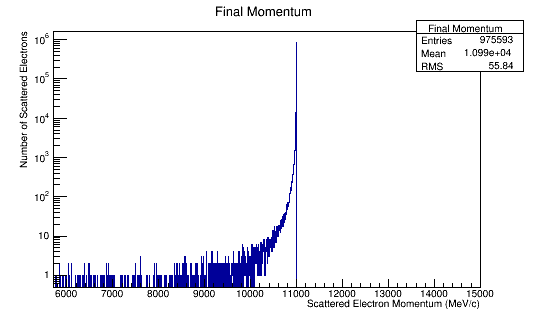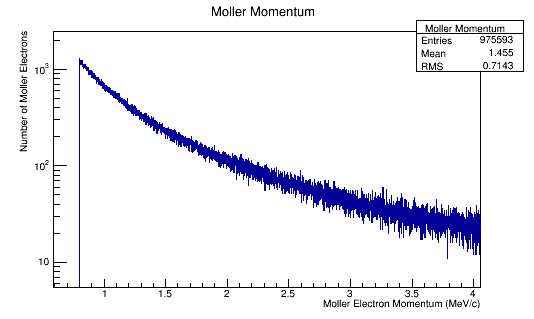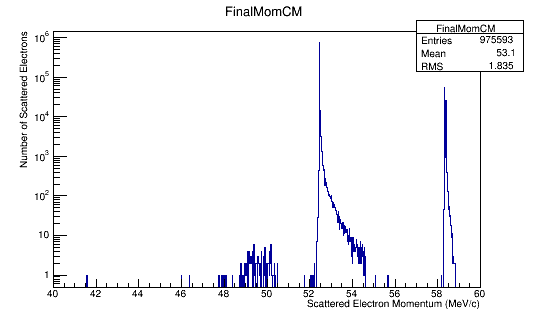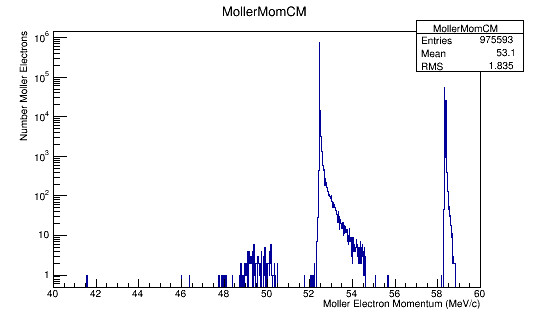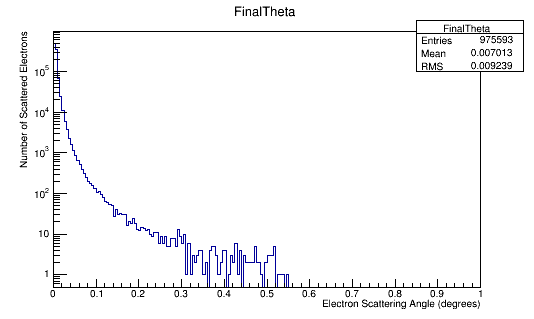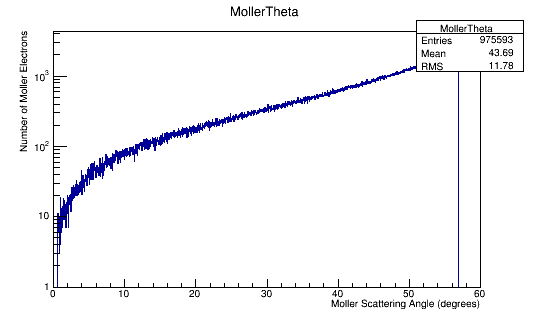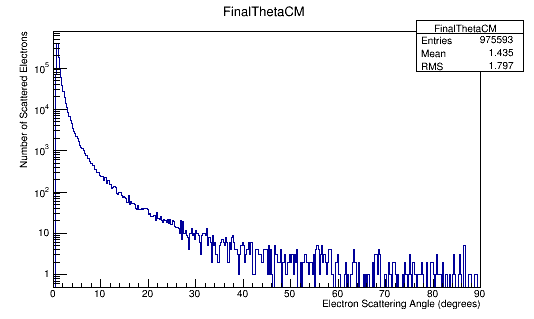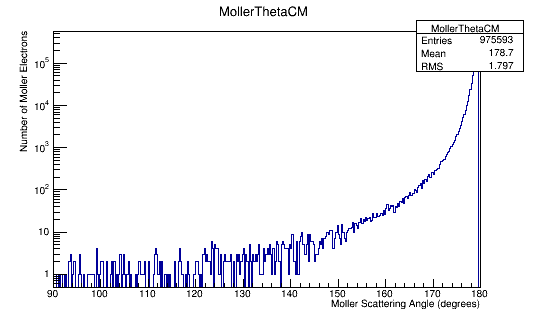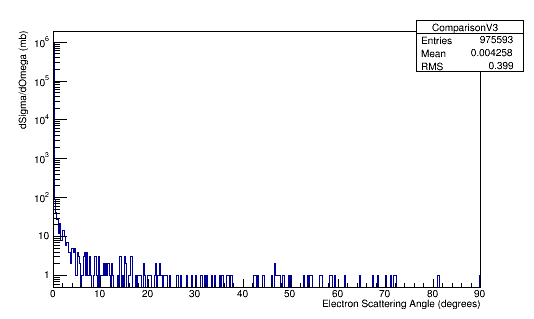DV RunGroupC Moller
Simulating the Moller scattering background for EG1
Step 1
Determine the Moller background using an LH2 target to check the physics in GEANT4
Incident electron energy varies from 1-11 GeV.
LH2 target is a cylinder with a 1.5 cm diameter and 1 cm thickness.
(Following dimensions listed on page 8 of File:PHY02-33.pdf)
Numbers Moller electrons per incident electron.
While 2nd and 3rd generations are created, only 2 2nd generation daughter particles are created for 1E6 incident particles. All knock on electrons are not counted.
Momentum distributions in the Lab Frame.
Momentum distributions in the Center of Mass Frame.
Estimated Momentum Distribution
In the collision of two particles of mass m_1 and m_2, the total energy in the center of mass frame can be written
where θ is the angle between the particles. In the frame where one particle (m2) is at rest
where in MeV
The velocity of the center of mass in the lab frame is
where plab≡p1 lab and
This gives the momenta of the particles in the center of mass to have equal magnitude, but opposite directions
For an incoming electron with momentum of 11GeV, we should find the momentum in the center of mass to be around 53 MeV which is confirmed in the the data/plots.
Simulation Verification
Sample output from GEANT4 simulation:
| KEi | Pxi | Pyi | Pzi | xi | yi | zi | KEf | Pxf | Pyf | Pzf | xf | yf | zf | KEm | Pxm | Pym | Pzm | xm | ym | zm |
|---|---|---|---|---|---|---|---|---|---|---|---|---|---|---|---|---|---|---|---|---|
| 11000 | 0 | 0 | 11000.5 | 0 | 0 | -510 | 10999.1 | 0.433025 | -0.858867 | 10999.6 | 0 | 0 | -509.276 | 0.905324 | -0.433025 | 0.858867 | 0.905366 | 0 | 0 | -509.276 |
Running a GEANT simulation just to put this set into a .dat file, then using the .dat file through the Moller_OG.C file in ROOT, we find in the Lab Frame:
Fnl4Mom.P 10999.599651 Fnl4Mom.E 10999.610609 Mol4Mom.P 1.320928 Mol4Mom.E 1.416324 Fnl4Mom.Theta(degrees) 0.005013 Fnl4Mom.Theta(radians) 0.000087 Mol4Mom.Theta(degrees) 46.756514 Mol4Mom.Theta(radians) 0.815641
Fnl4Mom.P 52.455386 Fnl4Mom.E 54.704969 Mol4Mom.P 52.455386 Mol4Mom.E 52.457875 Fnl4Mom.Theta(degrees) 1.051202 Fnl4Mom.Theta(radians) 0.018338 Mol4Mom.Theta(degrees) 179.040096 Mol4Mom.Theta(radians) 3.123255
Explaining graph distribution
Trying to explain the graphs, we look at the data files for strange KE, hence weirder momentums
| KEi | Pxi | Pyi | Pzi | xi | yi | zi | KEf | Pxf | Pyf | Pzf | xf | yf | zf | KEm | Pxm | Pym | Pzm | xm | ym | zm |
|---|---|---|---|---|---|---|---|---|---|---|---|---|---|---|---|---|---|---|---|---|
| 11000 | 0 | 0 | 11000.5 | 0 | 0 | -510 | 9855.29 | -31.7166 | -6.48546 | 9855.75 | 0 | 0 | -501.365 | 1144.53 | 31.7166 | 6.48546 | 1144.59 | 0 | 0 | -501.365 |
| 11000 | 0 | 0 | 11000.5 | 0 | 0 | -510 | 10999.0996 | -0.152974 | -0.761885 | 10999.7 | 0 | 0 | -502.19 | 0.590904 | 0.152974 | 0.761885 | 0.590932 | 0 | 0 | -502.191986 |
Using the equations derived earlier,
For the KEf=9855.29 MeV, we find that
this gives
This explains the lower bound part of the graph in that some of the initial particles transfer a large amount of energy to the Moller electron.
For the second set of data, simulation finds the boost to be
| Pcm | Pxcm | Pycm | Pzcm | Ecm |
|---|---|---|---|---|
| 58.379341 | -0.152974 | -0.761885 | 58.374168 | 37.904019 |
Using the approximation used above doesn't give the Energy in the Center of Mass as 58 MeV, it yields 53 MeV. Using the other form,
Angular Distribution in the Lab Frame
Angular Distribution in the Center of Mass Frame
Comparing experimental vs. theoretical for Møller differential cross section 11GeV
Using the equation from Halzen and Martin (p121) to approximate Moller scattering (in the Center of Mass Frame)
Plugging in the values expected for a scattering electron:
Using unit analysis on the term outside the parantheses, we find that the differential cross section for an electron at this momentum should be around
Using the conversion of
We find that the differential cross section is
Converting the number of electrons to barns,
where ρtarget is the density of the target material, ltarget is the length of the target, and iscattered is the number of incident particles scattered.
Step 2
Replace the LH2 target with an NH3 target and compare with LH2 target.
Step 3
Determine impact of Solenoid magnet on Moller events
Papers used
A polarized target for the CLAS detectorFile:PHY02-33.pdf
An investigation of the spin structure of the proton in deep inelastic scattering of polarized muons on polarized protons File:1819.pdf
